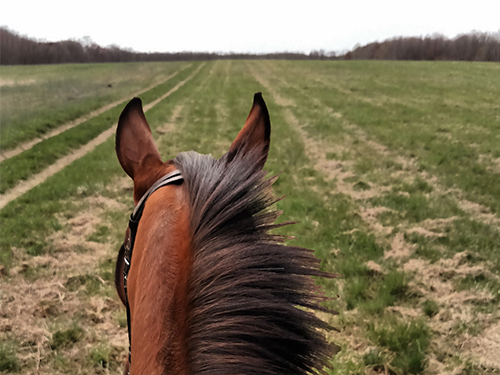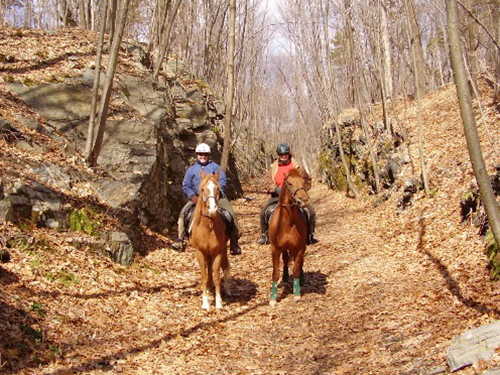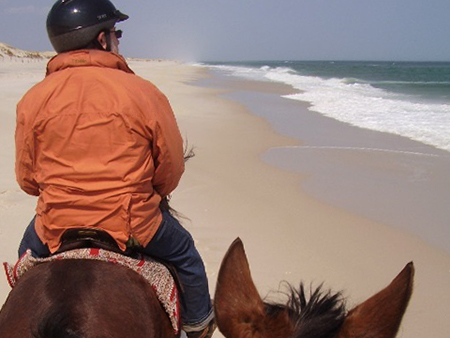
Fact Sheet FS370
When riding on multi-use trails, everyone needs to be aware of not only safety concerns for the rider and the horse but also show courtesy for other trail users on multi-use trails. All safety precautions and tips on riding should be practiced. However, additional practices apply specifically to trail riding; be it individual or group, short- or long-distance, for fun or for competition. These are all topics that will be covered in this fact sheet.
Out on the Trail
It is best not to ride alone. If you do, tell someone where you are going and what time you expect to be back. Consider carrying a whistle or cell phone to use in case of an emergency. It takes less effort to blow a whistle than to yell for help, or dial your cell phone.
Consider attaching an ID tag to your horse when trail riding. The tag should include the horse’s name, your name, and your cell phone number. Should you become separated from your horse and are some distance from home, your cell phone number will aid anyone who has caught your horse in reuniting it with you.

Figure 1. Horses being ridden on a designated and signed trail.
Carry a current map of the area or make sure your cell phone navigation system is working properly and that you have an idea where you are going. Study the area around you, noting landmarks. Occasionally look behind you to help recognize the trail for your return. Use fluorescent clothespins to clip to branches along the trail to help mark your return. Remember to remove the markers on the return trip.
Stay on designated or marked trails. Do not ride horses at a pace greater than a walk on muddy trails. You should cross rivers, creeks, or wetland only in designated areas to guard against adverse impact on the environment and for your safety and that of your horse. Good riding etiquette prevents land abuse and destruction. If you ride on federal or state lands, ask park officials for their advice on the best trails to take or if there are any map changes. Ride only on lands offered for public or private use where you have permission to ride.
Horse and Tack Considerations
Your horse and its safety should be your number one priority.
The toughest weather conditions affecting a horse is hot, humid weather. Severe injury can result if the horse is exercised beyond the point of fatigue. On long, hot, and humid rides, carry a sponge on a length of rope. This makes it easy to drop the sponge in water to refresh or cool your horse. Walk the horse the last two miles of the trail ride and NEVER run back to the barn or trailhead!
Pay attention to several indicators of physical condition to prevent the horse from breaking down. These indicators include the general attitude and behavior of the horse, muscle and bone soreness, heart and respiration rate, condition of the feet, and body temperature.
Normal Resting Values:
Courtesy on the Trail

Figure 2. Tying horses to a hitching post at lunch.
If you stop for lunch, make sure your horse rests in a safe place for the horse and other trail users. Stay with your horse and be considerate of other trail users. If it is permissible to have the horse rest off of the trail, do not tie your horse directly to a tree. Use two lightweight 8-foot lines with panic snaps and secure your horse between two trees. This will prevent the horse from chewing the bark and damaging the root system. Leave what you find and carry out what you packed. If you do stop for a rest on a long ride, remember to loosen the girth or cinch and tighten it before remounting.
Water should be offered to a horse at any available point on the trail if the trail permits horse access. If there is no access, do not attempt to enter the water. Entering rivers or streams in undesignated areas can cause damage to the environment, be unsafe for the horse, and may result in the trail being closed to horses.
When trailering and/or using a public park, please be considerate of other users and clean up any manure. Do not toss it into the bushes unless you have asked the proper officials if this is acceptable.
Trail Riding Safety

Figure 3. Wearing helmets while out on a trail.

Figure 4. Respect others that use the trails and follow the 'share the trail' signs.
Know the Law and Know your Horse
Listed below are New Jersey traffic laws you should be aware of. You have rights and you have responsibilities:
39:4–72. Operating motor vehicle near horses; violation and penalties
a. When approaching or passing a person riding or driving a horse, a person driving a motor vehicle shall reduce the vehicle’s speed to a rate not exceeding 25 miles an hour and proceed with caution. At the request of or upon a signal by putting up the hand or otherwise, from a person riding or driving a horse in the opposite direction, the motor vehicle driver shall cause the motor vehicle to stop and remain stationary so long as may be necessary to allow the horse to pass.
b. The administrator shall include in the New Jersey Driver’s Manual information explaining the requirements of subsection a. of this section and cautioning licensees on the need to exercise caution when operating a motor vehicle near horses.
c. A person who violates subsection a. of this section shall be subject to a fine of $150.

Figure 5. Traffic signs corresponding to law '39:4–72.'
NOTE: Carry a pen and paper so that you can note the vehicle, the license number, and location of any incident involving motor vehicles. You need to report the incident within 30 days (take a copy of this law with you) to the municipal court where the incident happened. All municipal courts are where citizen complaints begin, whether there is property damage or personal injury. In towns with no police department or municipal court, call the County Prosecutor’s Office to find out where citizen complaints for that town are to be filed.
Once Home
After a ride, the horse’s welfare should be your main concern.
With all these considerations in mind, you are ready to experience the pleasure and challenge of a trail ride. When the rider knows and practices common sense, safety, and consideration for others on the trail, both the horse and rider enjoy the ride.
Suggested Reading
Photo credit: C. Williams, Extension Specialist, Rutgers University; J. Elsishans, S. Data Samtak
September 2024
Copyright © 2025 Rutgers, The State University of New Jersey. All rights reserved.
For more information: njaes.rutgers.edu.
Cooperating Agencies: Rutgers, The State University of New Jersey, U.S. Department of Agriculture, and Boards of County Commissioners. Rutgers Cooperative Extension, a unit of the Rutgers New Jersey Agricultural Experiment Station, is an equal opportunity program provider and employer.



